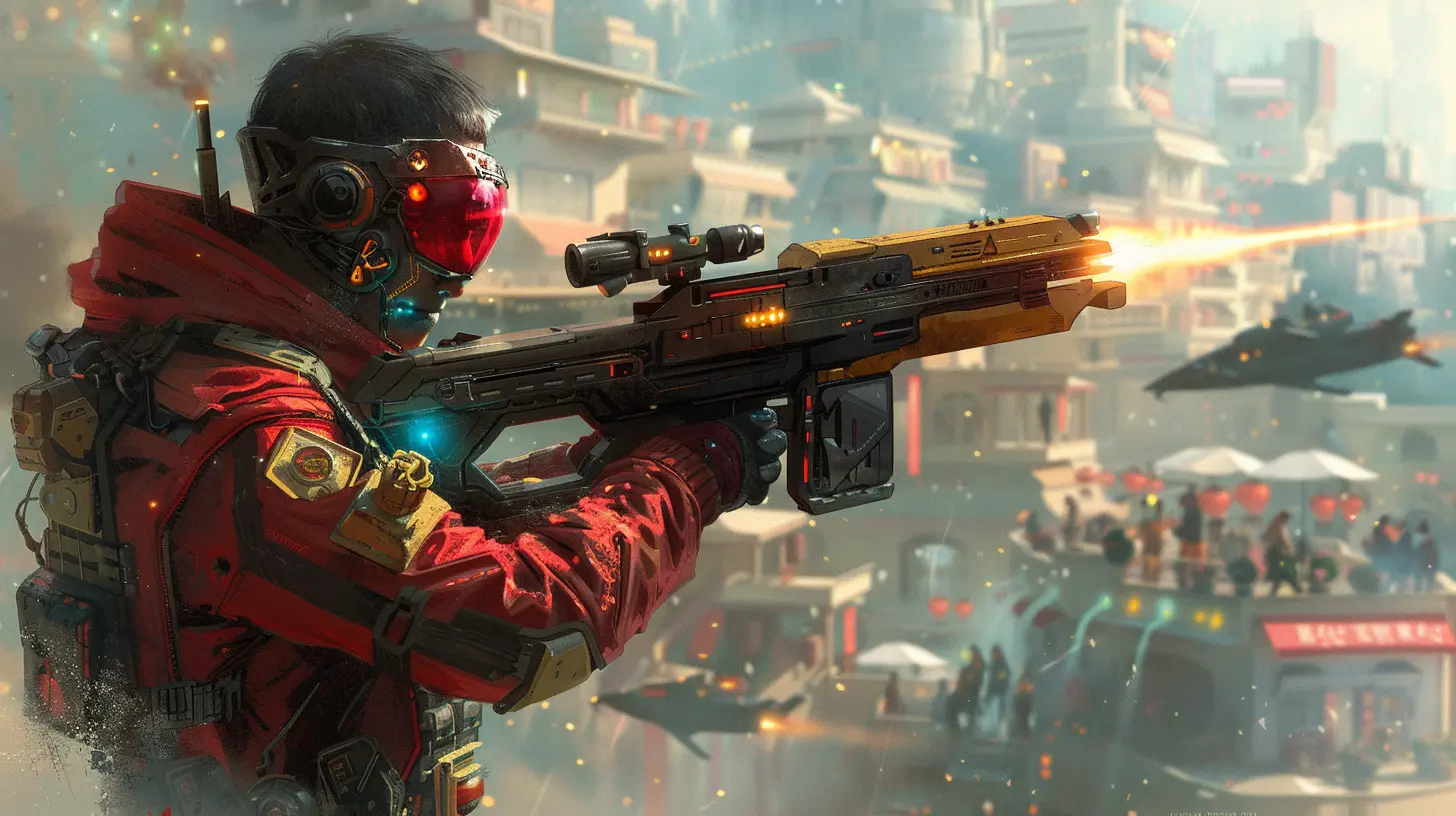The Future of Action Games: More Than Just Reflexes
4 November 2025
Let’s face it—action games have always been adrenaline-pumping, heart-racing, and reflex-testing experiences. From dodging bullets in "Call of Duty" to pulling off jaw-dropping combos in "Devil May Cry", our twitch reflexes have been at the center of it all. But here’s the twist: the future of action games isn't just about how fast you can press buttons anymore.
As technology advances and gamer expectations evolve, action games are shifting gears. Reflexes are still important, sure, but there’s a growing demand for depth—emotional storytelling, intelligent decision-making, immersive environments, and smarter AI.
So buckle up, because we’re diving deep into how the action genre is transforming in ways you might not expect.
🎮 What Makes an Action Game “Action”?
Before we race ahead, let’s hit pause for a second. What even defines an action game?At its core, an action game tests your motor skills. Fast inputs, timing, movement, hand-eye coordination—you get the idea. Whether it's shooting, slashing, jumping, or running, there’s constant motion and interaction. Think of it like the video game version of an action movie, where you're the stunt double calling the shots.
But that’s the old-school recipe. The new-age action game? It’s part athleticism, part chess match, and part cinematic experience.
🧠 Strategic Thinking is the New Reflex
Ever felt like you were playing a game of 4D chess while ducking bullets? That’s where action games are heading. Developers are blending reflex-based mechanics with thoughtful strategy.Take Sekiro: Shadows Die Twice, for example. It’s not just about mashing buttons—you need to study enemy patterns, time your parries, and plan every move like a samurai in a duel.
The same goes for DOOM Eternal. Sure, it’s fast-paced, but there’s a rhythm to the chaos. The game practically turns into a brutal ballet if you're playing it right—where weapon switching, ammo management, and movement all demand quick thinking.
The point? Action games are evolving into a dance of brains and brawn.
🤖 AI is Changing the Game—Literally
Let’s talk about the elephant in the room: artificial intelligence. Not the scary, world-ending Skynet kind, but the type that makes enemies smarter and allies more helpful.Old-school AI was predictable. Once you learned patterns, you could breeze through. But the future? Adaptive AI. Enemies will respond based on your playstyle. Hide behind cover too much? They’ll flank you. Prefer rushing in guns blazing? They’ll trap you.
Games like Middle-earth: Shadow of Mordor introduced systems like the Nemesis System, where enemies remember interactions with you. They evolve. They remember how you fight. That’s not just AI—that’s digital revenge.
This kind of dynamic interaction is turning action games into more personal and unpredictable experiences.
🎥 Storytelling and Character Development in Action Games
Can we talk about how action games now tug at our heartstrings?Gone are the days of “shoot first, ask questions later.” Today’s action games invest in world-building and emotional depth.
Take The Last of Us Part II. It's an action game, but you spend just as much time feeling as you do fighting. It’s gritty, emotional, and impossible to forget. The story sticks with you longer than any boss fight.
Or God of War (2018)—Kratos went from a rage-fueled demigod to a struggling father battling his past. Who saw that coming?
The future of action games involves this seamless blend of narrative and gameplay. Not just playable set pieces, but interactive stories where your actions carry weight far beyond the battlefield.
🌐 Immersive Tech Is Leveling Up the Experience
Raise your hand if you’ve been blown away by ray tracing or 3D audio recently. Yup, us too.Technology is pushing immersion to new heights. Here’s how:
- Virtual Reality (VR): Titles like Half-Life: Alyx prove that action in VR isn’t just gimmicky—it can be game-changing. You physically dodge attacks and reload weapons. It’s intense.
- Haptics and Adaptive Triggers: With the PS5’s DualSense controller, you can actually feel the tension of drawing a bowstring or the rumble of a heavy gun. That tactile feedback adds a whole new layer to the experience.
- Facial Animation and Motion Capture: Characters are more lifelike than ever, making engagement deeper. When Kratos grimaces, you feel that grimace.
Technology isn’t just enhancing visuals—it’s making every action, every shot, every blow feel real.
🎓 Skill Trees, Builds, and Customization Galore
Remember when action games were all about “pick up gun, go boom”?Now, we’re customizing builds like we’re RPG veterans. Skill trees, weapon crafting, ability upgrades—all that good stuff is becoming a standard part of modern action games.
Games like Ghost of Tsushima let you tailor your playstyle. Want to be a sneaky assassin or a head-on samurai? It’s up to you. These elements add layers of personalization that extend replay value and deepen player agency.
We’re not just playing the game—we’re shaping how it plays.
🧑🏫 Learning Curve = Bigger Payoff
Here’s the thing: action games are no longer afraid to throw players into the deep end. And that’s a good thing.They challenge you. They demand growth. Maybe you’ll die a hundred times (looking at you, Elden Ring), but when you finally beat that boss? Oh man, pure euphoria.
It's no longer about instant gratification. Developers are designing games with purposefully steep learning curves so victory feels earned.
And let’s be honest—beating a game that actively humbles you feels way better than breezing through one that holds your hand.
🧍♂️ Multiplayer That’s About More Than Just Shooting
Multiplayer action isn’t just scoreboard-chasing anymore. It’s about cooperation, communication, and objective-based gameplay.Think Apex Legends—an action-packed battle royale where teamwork matters as much as shooting skills. Or Warframe—a wild space ninja spectacle that rewards coordination and strategy.
Heck, even MOBAs like League of Legends combine real-time action with deep strategy. While not traditional action games, they borrow heavily from the genre and influence its evolution.
Friend or foe, the lines are blurring. Multiplayer modes are becoming smarter, deeper, and—most importantly—more engaging.
🧬 The Genre Hybridization Wave
Ever played a game and thought, “Wait, is this an action game or an RPG… or both?”Say hello to hybrid genres.
Developers are mixing and matching like it’s a genre buffet. Action-RPGs. Action-strategy. Action-survival. This blending creates richer gameplay loops that appeal to a broader audience.
Titles like Horizon Forbidden West or Cyberpunk 2077 combine open-world exploration, dialogue choices, and deep progression systems with fast-paced action. You get the thrill of combat with the richness of an open-ended world.
The future is flexible. Action games no longer live in a box—they’re breaking it entirely.
🧠 Accessibility and Inclusivity: Action for All
Here’s something worth celebrating: action games are becoming more inclusive. Not everyone can react with lightning-fast precision, and game devs are finally recognizing that.Titles now include customizable difficulty settings, visual and auditory aids, and control remapping. The Last of Us Part II practically set the gold standard with over 60 accessibility options.
Why does that matter?
Because the future of action games should be about fun and challenge for everyone—not just the elite twitchy-finger crowd.
🔮 So, What’s Next?
Let’s daydream a bit. Imagine this:- AI companions that develop actual relationships with you.
- Real-life weather data affecting in-game physics.
- Personalized storylines shaped by your moral decisions.
Sounds straight out of sci-fi? It’s closer than you think.
Cloud gaming, neural feedback systems, and next-gen consoles are all stepping stones toward truly immersive action games that blend reflexes, strategy, story—and maybe even emotion-reading tech?
Okay, maybe that last one's a bit much. (Or is it?)
🕹 Final Thoughts: It's a New Era for Action Games
We’re not just talking about faster frame rates and flashier explosions. The real evolution of action games is happening under the hood—in design philosophies, player agency, inclusivity, and intelligent gameplay.Reflexes will always matter. But the future? It belongs to players who can think, feel, adapt, and build stories through their gameplay.
So next time you boot up a new action title, don’t just ask, “How fast can I shoot?” Ask, “What kind of experience am I about to create?”
Because action games aren't just games anymore—they're digital adventures waiting to be shaped by you.
all images in this post were generated using AI tools
Category:
Action GamesAuthor:

Tina Fisher
Discussion
rate this article
1 comments
Sienna Kline
Excited to see depth and creativity in future action games!
November 14, 2025 at 3:34 PM

Tina Fisher
Thank you! We're excited to explore new dimensions in action games that emphasize both depth and creativity!


